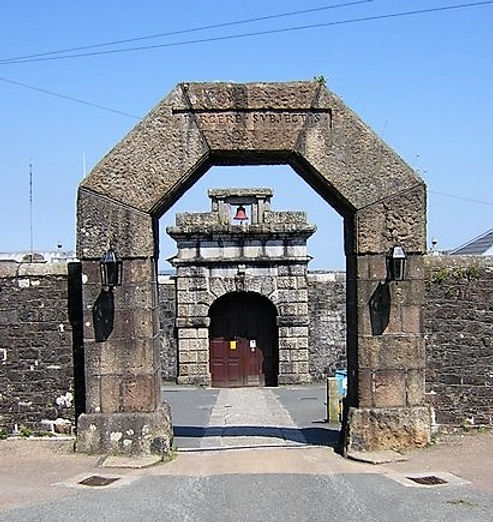Throughout history, prisons have been an integral part of the criminal justice system in the UK. From the dark dungeons of medieval castles to modern-day correctional facilities, prisons have evolved significantly over time. In this blog, we will delve into the fascinating and often-grim history of prisons in the UK, exploring how they were used to punish criminals, deter crime, and ultimately rehabilitate offenders.
We will examine the changing attitudes towards imprisonment as a form of punishment, looking at everything from early prison reform movements to modern-day debates around overcrowding and prison conditions. So grab your key and open the cell door as we take a journey through the history of prisons in the UK!
1. The Emergence of the First National Penitentiary in Britain
The emergence of the first national penitentiary in Britain marked a significant step in the development of the country’s prison system. The Millbank Penitentiary, built in London in 1816, was based on the penitentiary theories of Jeremy Bentham, who advocated for a system of solitary confinement and hard labour.
However, the prison was originally designed to hold all offenders, including men, women, and children, before being extended to only accommodate men from 1850. It was an important move towards the reformation of prisons from the brutal, unsanitary conditions that had previously existed.
The establishment of Millbank penitentiary set a precedent for future institutions, highlighting the importance of rehabilitation and reformation in the penal system.
2. The Use of Old Ships as Prisons in London Docks
The loss of the American colonies created a crisis for Britain in finding places to confine prisoners. As a result, old decommissioned ships were used as prisons in London Docks, known as “prison hulks”. These vessels were used to house prisoners of war or convicts with sentences ranging from months to life, for nearly a century.
Prisoners on the hulks experienced terrible conditions, living in cramped, unsanitary quarters with little to no access to fresh air or exercise. Despite the harsh conditions, these prison hulks remained in use until the mid-19th century, when they were eventually phased out in favor of newer, purpose-built facilities.
3. The Impact of the Loss of American Colonies on Prisons
The loss of the American colonies had a significant impact on the British prison system. With nowhere to send prisoners, Britain had to find new solutions to its criminal problems. The answer was to reform the police and build more prisons. From 1842 to 1877, 90 new prisons were built or added across England and Wales. However, reformers were shocked by the sordid conditions, lack of discipline, and treatment of prisoners in these facilities.
This led to a dilution of the separate system, the abolition of hard labor, and established the idea that prison work should be productive. The impact of the loss of American colonies highlighted the need for change and prompted a new era of prison reform in Britain.
4. The Prison Reform Movement in England
The emergence of the prison reform movement in England was a crucial turning point in the history of UK’s penal system. This movement was largely driven by the complaints made by John Howard in his book, “The State of the Prisons in England and Wales,” which denounced the appalling conditions in prisons.
The movement sought to establish a regime of solitary confinement and religious instruction, with the aim of rehabilitating prisoners to become better members of society. The movement brought about significant changes such as the professionalization of prison guards, the segregation of male and female inmates, and more sanitary hygiene conditions in prisons, laying the foundation for a more humane and effective penal system in the UK. These reforms were eagerly taken up in the 19th century and continue to shape the penal system to this day.
5. The Publication of
The publication of John Howard’s “The State of the Prisons in England and Wales” in 1784 marked the beginning of the prison reform movement in England. Howard’s report detailed the inhumane conditions prisoners faced, including overcrowding, disease, and violence. It sparked a public outcry and led to the establishment of the penitentiary system, where prisoners were housed in isolated cells and subjected to strict discipline and hard labor.
The publication of Howard’s report also led to a renewed interest in the role of punishment in society and the need for rehabilitation rather than mere retribution. The ideas put forth in “The State of the Prisons” continue to influence prison reform movements around the world today.
6. The Establishment of Millbank as a State Penitentiary
The establishment of Millbank as a state penitentiary in 1816 marked a significant development in the history of prisons in the UK.
Initially built to house convicted male and female felons serving long sentences, Millbank was designed as a penitentiary for convicts sentenced to terms of imprisonment, or for those whose sentences were commuted to transportation. Costing £500,000 to construct, an immense sum at that time, Millbank was hailed as the greatest prison in Europe upon its completion in 1821.
Its unique six-spoke radial design was intended to provide a more humane and efficient form of punishment, with prisoners separated into separate wings to prevent them from communicating with one another.
Although it was gradually replaced by new, centralized prisons such as Pentonville and Brixton, Millbank stood for nearly a century as a well-known, gloomy pile on the riverbank with a legacy that helped shape the future of prison reform in the UK.
7. The Rise in Crime Rates during the Victorian Era
During the Victorian era, crime rates in Britain rose dramatically, causing great concern among the population. This rise in crime was attributed to a variety of factors, including the impact of the industrial revolution on society, poverty, and the increasing divide between social classes. In response to the rising crime rates, the authorities implemented tougher prison regimes and began a program of penal reform.
This led to the construction of a significant number of prisons across the country, with many prisons still in use today. The Victorian period also saw a transition towards a modern penal policy, with prisons to be viewed not just as places of punishment, but also as places of rehabilitation for offenders. This approach to penal reform has had a lasting impact on the UK criminal justice system.
8. The Tough Prison Regimes Adopted during the Victorian Era
During the Victorian era, the rising crime rate in Britain led to the adoption of tough prison regimes; this was a response to a perceived need to deter criminals and promote the idea of rehabilitation. The Silent System, which advocated reform through silence and hard labor, was increasingly implemented in prisons after the 1865 Prisons Act. It aimed to create a disciplined environment for prisoners, with strict rules on silence and a focus on hard work. T
he separate system was also promoted in Victorian prisons, where prisoners were isolated from each other to prevent corruption and sin. Although there were criticisms of these harsh regimes, the idea that prisoners had to work hard to earn their redemption remained popular. This approach continued to influence penitentiary design and prison reform ideas well into the 20th century.
9. Continuities in Penal Reform Ideas from the 16th to the 18th Centuries
Prison reform ideas have been circulating in England since the 16th century, with continuities observed over the centuries. John Howard, a noted prison reformer in the 18th century, condemned the prison system as disorganised, barbaric, and filthy. In the late 17th to early 18th centuries, Shoemaker’s study highlighted the prosecution and punishment of misdemeanours.
The Prison Reform Trust, a UK charity, works towards creating a just and safe prison system in the 21st century. The prison system struggles particularly to reform younger offenders aged 18-20. Despite calls for reform, penal reform has demonstrated continuities over the centuries. The changing roles of prisons in the UK are demonstrated by Newgate, Millbank, and Pentonville.
10. The Changing Roles of Prisons in the UK Demonstrated by Newgate, Millbank, and Pentonville.
The changing roles of prisons in the UK can be best demonstrated by the historical development of Newgate, Millbank, and Pentonville. These three London prisons reflect the evolution of the purpose of imprisonment in the country from being used to keep offenders in safe custody or used as punishment in itself, to become a tool for rehabilitation and reintegration of offenders into society. For instance, Pentonville was designed for the implementation of the separate system of prison discipline in 1842, which aimed to reform prisoners through solitary confinement and hard labor.
Similarly, Millbank became the first modern prison in London in 1816, demonstrating the shift towards incarceration as a means of punishment. This transformation of prisons in the UK reflects the broader changes in society’s attitudes towards crime and punishment over the centuries, and the ongoing efforts to improve the justice system and reduce reoffending rates.







